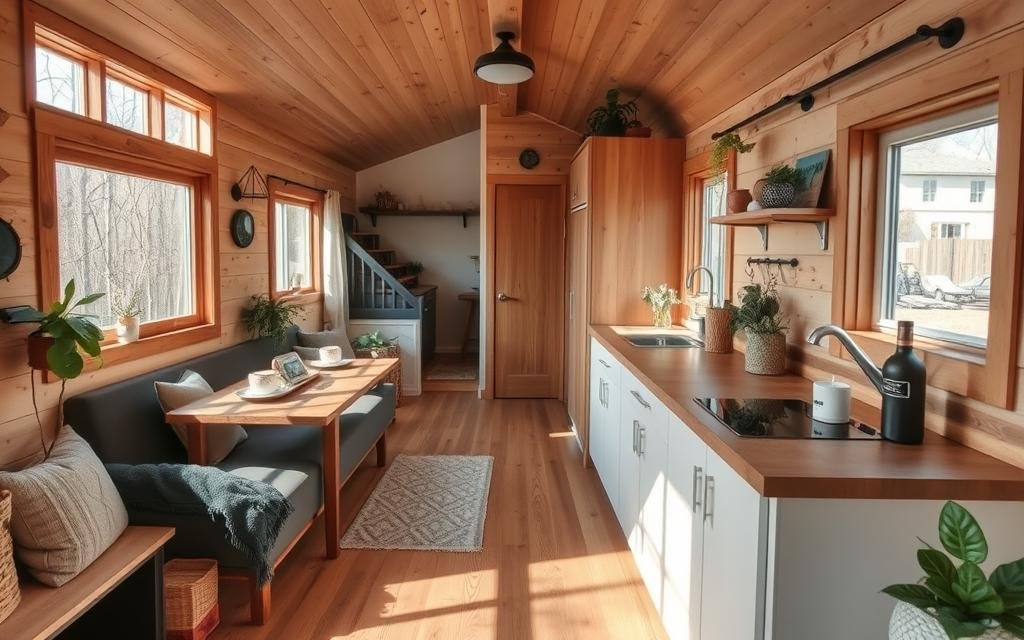In recent years, there has been a significant cultural shift toward minimalist living and space efficiency. More people are embracing compact living spaces as a way to simplify their lives and reduce their environmental footprint. This movement isn’t just about downsizing; it’s about creating functional, stylish, and sustainable environments.
Modern compact spaces now prioritize innovative design over mere size reduction. From multi-functional furniture to smart technology, these homes are built to maximize every square foot. The focus is on blending practicality with aesthetics, ensuring that small spaces feel open and inviting.
Rooted in sustainability and financial freedom, this lifestyle continues to gain momentum. Prefab ADUs and modular construction are also rising in popularity, offering customizable and eco-friendly solutions. As we look ahead, expect to see more emphasis on eco-friendly materials and cutting-edge designs that redefine compact living.
Table of Contents
Key Takeaways
- Minimalist living is gaining traction as a way to simplify lifestyles.
- Innovative design is transforming compact spaces into functional homes.
- Sustainability and financial freedom are core principles of this movement.
- Prefab ADUs and modular construction are becoming popular choices.
- Multi-functional furniture and smart tech are key features of modern designs.
Introduction to Tiny Home Design Trends
Compact living spaces are redefining how people think about housing in the 21st century. What began as a niche lifestyle choice has grown into a mainstream movement, driven by rising costs and a desire for simplicity. The tiny house movement is now a symbol of innovation and sustainability.
One major factor behind this shift is the increasing cost of traditional homes. Many individuals, especially millennials, are opting for houses under 400 square feet to save money and reduce their environmental impact. These smaller spaces also require less maintenance, making them ideal for busy lifestyles.
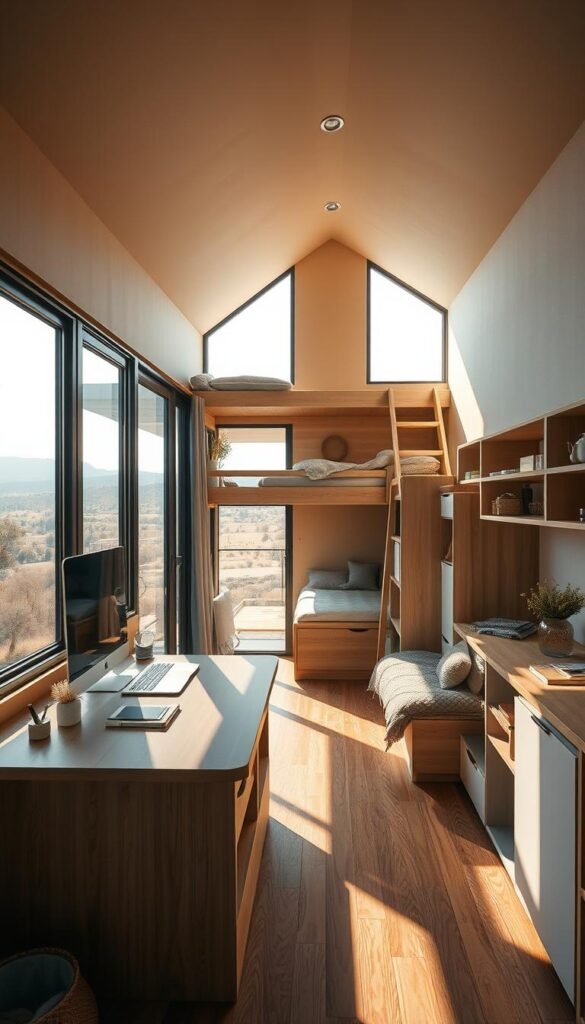
Remote work has further fueled the demand for compact living. With more people working from home, the need for large spaces has diminished. Smaller homes offer a practical solution, allowing individuals to live comfortably while reducing their carbon footprint. In fact, these homes use 40% less energy than traditional houses.
Design innovations have played a crucial role in making compact living feasible. From multi-functional furniture to creative storage solutions, every inch of these homes is optimized for efficiency. The result is a small space that feels open, stylish, and functional.
| Aspect | Traditional Homes | Compact Homes |
|---|---|---|
| Average Size | 2,500 sq ft | 100-400 sq ft |
| Energy Use | High | 40% Lower |
| Maintenance | Time-Consuming | Minimal |
| Cost | Expensive | Affordable |
As the demand for efficient living grows, so does the creativity in design. These homes are no longer just about saving space—they’re about creating a lifestyle that’s both practical and inspiring.
Maximizing Space with Multi-Functional Furniture
Creative furniture solutions are transforming how we use limited spaces. In compact living environments, every square foot counts. Multi-functional pieces are now essential for making the most of small areas. These designs blend practicality with style, ensuring that interiors remain both functional and inviting.
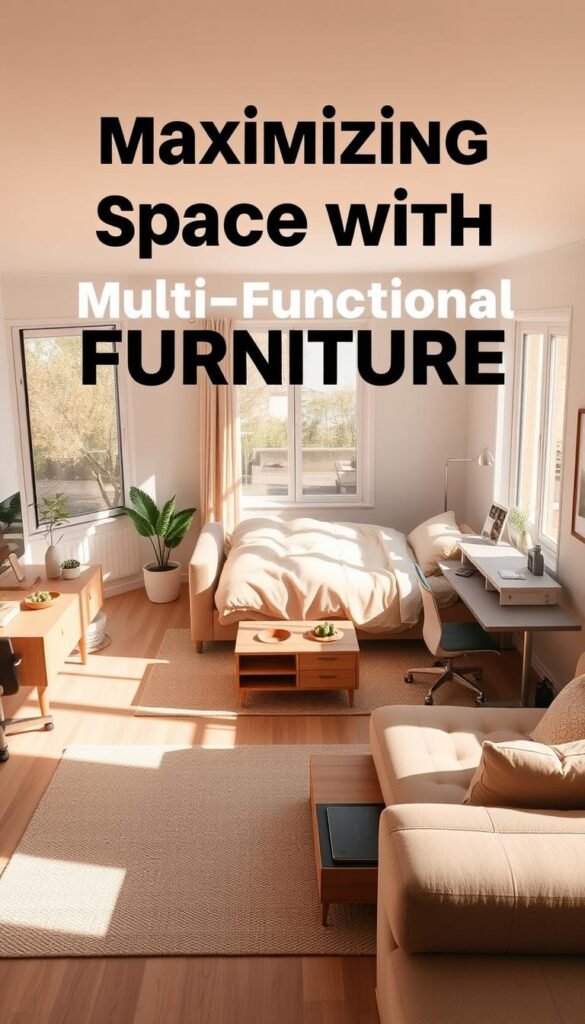
Innovative Storage Solutions
One of the most effective ways to maximize space is through smart storage. Recessed storage, like under-stair coat closets, keeps items out of sight while maintaining a clean look. Vertical shelving is another great option, utilizing wall space to free up the floor. Brooklyn Home Company’s reclaimed wood kitchen island is a prime example, doubling as both a workspace and storage unit.
Convertible Furniture Designs
Convertible furniture is a game-changer for small spaces. Foldable tables and sofa beds allow rooms to serve multiple purposes. Cameron Ruppert’s wallpapered laundry closet shows how hidden storage can be both stylish and functional. These designs ensure that every piece of furniture works harder, reducing clutter and enhancing efficiency.
By combining innovative storage and convertible furniture, it’s possible to create a functional and aesthetically pleasing interior. These solutions are perfect for homes under 300 square feet, proving that size doesn’t limit style or comfort.
Eco-Friendly Materials and Sustainable Design
Sustainability is at the heart of modern living, shaping how we build and inhabit spaces. As more people embrace eco-conscious lifestyles, the demand for sustainable materials and energy-efficient systems has grown. This shift is particularly evident in compact living, where every design choice impacts both functionality and environmental impact.
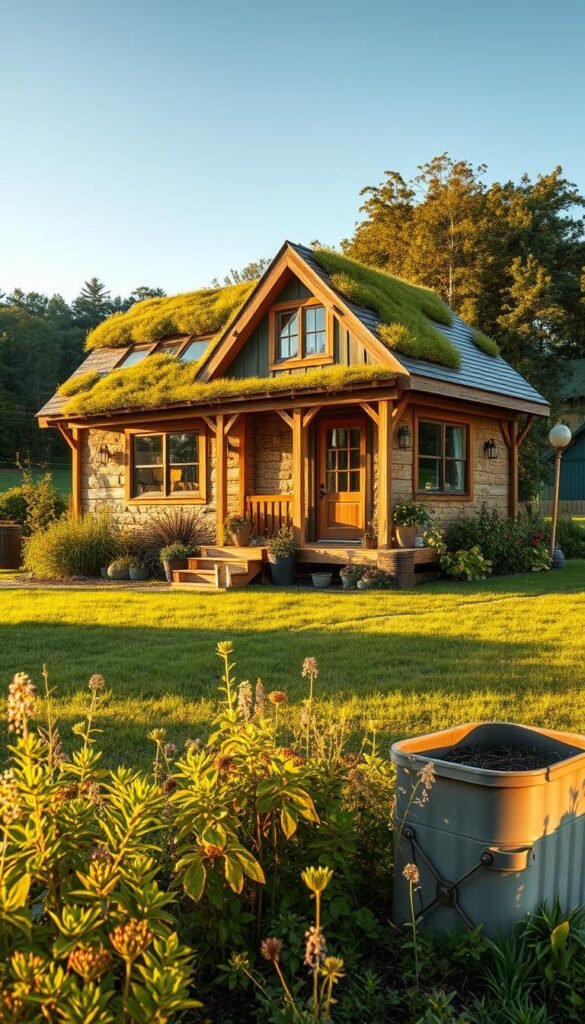
Recycled and Reclaimed Materials
One of the most popular trends in eco-friendly housing is the use of recycled and reclaimed materials. For instance, reclaimed wood accents add warmth and character while reducing the need for new lumber. Recycled metal roofing is another standout choice, offering durability and a lower environmental footprint.
Bambi Costanzo’s 1920s bungalow is a prime example, featuring reclaimed windows that blend history with modern sustainability. Reclaimed barn doors are also gaining traction, saving space and minimizing material waste. These choices not only look great but also contribute to a greener planet.
Energy-Efficient Systems
Energy efficiency is a cornerstone of sustainable living. Solar panels, for example, can cut energy costs by up to 50%, making them a smart investment for compact spaces. Composting toilets and greywater recycling systems further enhance off-grid capabilities, reducing reliance on traditional utilities.
HVAC systems tailored for spaces under 500 square feet are another innovation. These systems ensure optimal climate control while minimizing energy use. Combined with LED lighting, which reduces energy consumption by up to 80%, these solutions make compact living both practical and eco-conscious.
| Feature | Benefit |
|---|---|
| Reclaimed Wood | Reduces demand for new lumber, adds aesthetic value |
| Solar Panels | Cuts energy costs by 50%, supports off-grid living |
| Composting Toilets | Reduces water usage, ideal for off-grid capabilities |
| Energy-Efficient HVAC | Optimizes climate control for small spaces |
For more insights on sustainable tiny house design, explore how these practices can transform your living space. By integrating eco-friendly materials and energy-efficient systems, you can create a home that’s both stylish and kind to the planet.
Smart Home Technology Integration
Technology is reshaping how we live, even in the most compact spaces. The rise of smart home innovations has made it easier than ever to maximize efficiency and convenience. From lighting to security, these advancements are transforming the way we experience compact living.
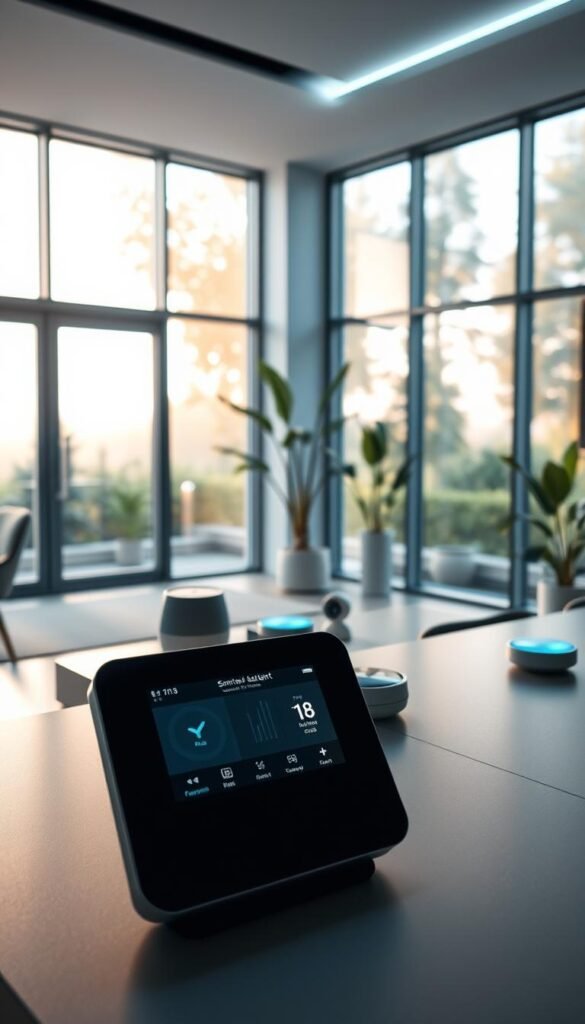
Automated Lighting and Climate Control
Voice-activated systems like Alexa-controlled LED lighting are a game-changer for small spaces. These systems allow users to adjust brightness and color with simple commands, creating the perfect ambiance without cluttering the room. Nest thermostats take it a step further, offering zone-based climate control that’s ideal for lofted areas.
These technologies not only enhance comfort but also save energy. By automating lighting and temperature, you can reduce utility costs while maintaining a cozy living space. It’s a practical solution for those who value both functionality and style.
Smart Security Features
Security is a top priority, even in compact homes. Smart locks with facial recognition provide an added layer of safety, especially for trailer-based setups. These locks are easy to install and offer peace of mind without compromising on space.
For those who need a tech-ready solution, the Autonomous WorkPod is a standout choice. Its plug-and-play design includes pre-wired outlets, making it simple to integrate smart devices. This approach ensures that even the smallest spaces can be equipped with cutting-edge technology.
By embracing these smart home innovations, you can create a compact environment that’s both efficient and secure. These design ideas prove that size doesn’t limit functionality or convenience.
Innovative Layouts for Tiny Homes
Innovative layouts are revolutionizing how we utilize small spaces. By focusing on efficiency and creativity, these designs make every square foot count. Whether it’s through loft beds or open floor plans, the goal is to create a functional and inviting environment.

Loft Living Spaces
Loft beds are a popular choice in 70% of compact homes. They maximize vertical space, freeing up the floor for other uses. For example, Chauncey Boothby’s designs include under-desk areas that double as workspaces. This approach ensures that every inch of the room is utilized effectively.
Vaulted ceilings, often seen in grain silo homes, add a sense of vertical spaciousness. These designs make small spaces feel larger and more open. Combined with loft beds, they create a cozy yet functional living area.
Open Floor Plans
Open layouts are another key trend, especially in homes under 700 square feet. Greg Dutton’s cottage is a great example, using an open floor plan to enhance airflow and natural light. This design eliminates unnecessary walls, making the space feel more expansive.
Sliding barn doors are replacing traditional swing doors, saving valuable space. These doors are both stylish and practical, fitting seamlessly into compact layouts. Dual-purpose zones, like dining tables that convert to workspaces, further enhance functionality.
By combining these elements, it’s possible to create a small space that feels open, stylish, and efficient. These innovative layouts prove that size doesn’t limit comfort or creativity.
Minimalist Aesthetics and Design
The art of simplicity is taking center stage in modern living spaces. Minimalist principles are reshaping how we approach interior design, focusing on clean lines, neutral tones, and uncluttered environments. This style not only enhances visual appeal but also creates a sense of calm and order.

By prioritizing functionality and elegance, minimalist aesthetics make even the smallest space feel open and inviting. Whether it’s a compact apartment or a tiny house, this approach proves that less can truly be more.
Neutral Color Palettes
Neutral tones are a cornerstone of minimalist design. Shades like white, beige, and soft gray create a timeless look while visually expanding the space. Brian Patrick Flynn’s blue and white palette is a perfect example, blending serenity with sophistication.
White shiplap walls, often seen in farmhouses, amplify natural light and add texture without overwhelming the room. These monochromatic schemes are ideal for interiors under 400 square feet, making them feel larger and more cohesive.
Decluttered Living Spaces
Decluttering is essential for achieving a minimalist aesthetic. Hidden compartments in storage benches and fabric-covered shelving, like Leanne Ford’s designs, keep items out of sight while maintaining a clean look. Kerri Pilchik’s high-gloss white cabinets are another standout, reflecting light and enhancing brightness.
Scandinavian-inspired simplicity is also gaining traction, especially in compact kitchens. By focusing on essential items and smart storage, these spaces remain functional and stylish. The result is a living space that feels open, organized, and effortlessly chic.
| Design Element | Benefit |
|---|---|
| Neutral Colors | Visually expand small spaces, create a timeless look |
| Hidden Storage | Reduce clutter, maintain a clean aesthetic |
| High-Gloss Cabinets | Amplify natural light, enhance brightness |
| Scandinavian Simplicity | Focus on essentials, maintain functionality |
Outdoor Living Spaces for Tiny Homes
Outdoor areas are becoming essential extensions of compact living spaces. These spaces not only enhance functionality but also create a seamless connection between indoor and outdoor living. Whether it’s a cozy patio or a lush garden, these additions maximize every square foot of your property.
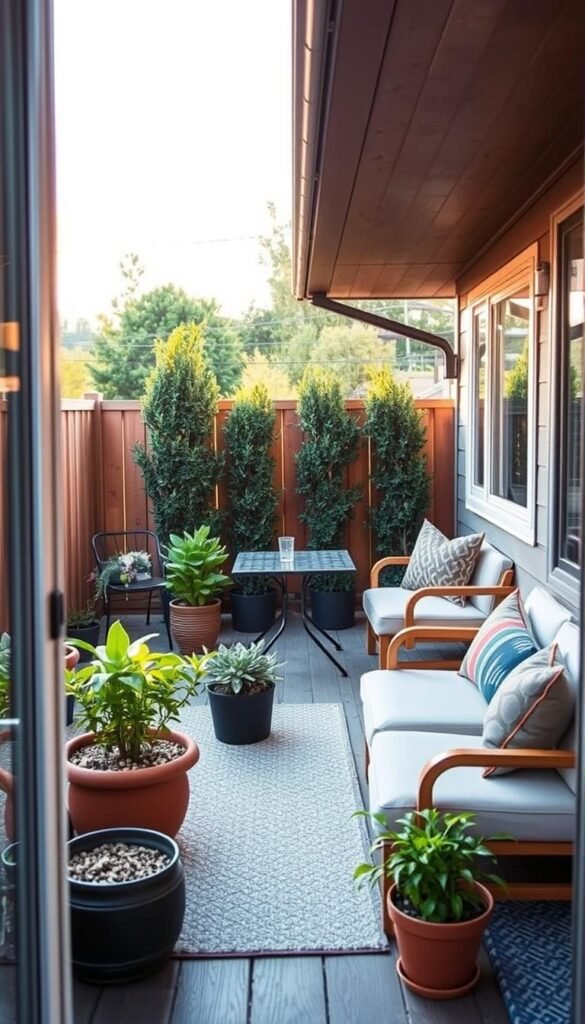
Patios and Decks
Foldable decks are a game-changer for trailer-based setups. They attach easily to the structure, providing a versatile outdoor area for relaxation or entertaining. Thomas Rhett’s rustic retreat showcases this perfectly, featuring an outdoor kitchen that blends practicality with style.
For those with limited space, foldable designs ensure that outdoor areas are both functional and portable. These decks can be adjusted to fit different needs, making them ideal for compact homes.
Gardens and Green Spaces
Vertical herb gardens are a popular choice for urban dwellers. They maximize space while adding a touch of greenery to your outdoor area. Amy Kleinwachter’s silo guesthouse takes this concept further, incorporating a fire pit and garden path for a cozy, inviting atmosphere.
Bee Camp’s open-air kitchen and Airstream sleeping combo is another standout example. This setup proves that outdoor spaces can add significant functional square footage to your property. By integrating these elements, you can create a seamless transition between indoor and outdoor living.
Outdoor spaces are more than just an extension of your home—they’re a way to enhance your lifestyle. From foldable decks to lush gardens, these additions make compact living both practical and enjoyable.
Customizable and Modular Tiny Homes
Customizable and modular living solutions are gaining traction as a practical alternative to traditional housing. These innovative approaches allow individuals to create spaces tailored to their needs, blending functionality with affordability. From prefab ADUs to flat-pack kits, the options are diverse and accessible.
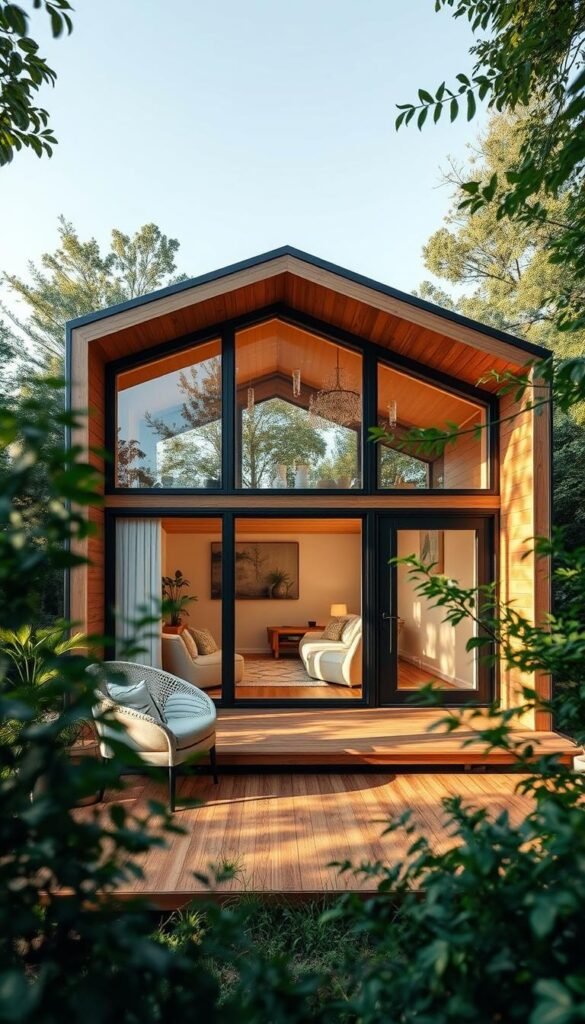
Prefab ADUs: Versatility and Efficiency
Prefab ADUs are transforming how we use space. Units like the Autonomous WorkPod Versatile serve as offices, studios, or guest rooms, offering flexibility for modern lifestyles. These structures are quick to install and cost-effective, making them ideal for urban and rural settings alike.
Jennifer Vaughn-Miller’s 1,000 sq ft coastal cottage is a prime example. Built using prefab elements, it combines sustainability with style. This approach not only saves time but also reduces construction waste, aligning with the principles of the tiny house movement.
Modular Construction Techniques
Modular construction is another game-changer. These techniques involve building sections off-site and assembling them on location. This method is 30% cheaper than traditional construction, offering significant cost savings. Companies like Reclaimed Space specialize in modular units that are both eco-friendly and customizable.
Flat-pack tiny home kits are also rising in popularity. These DIY-friendly options allow homeowners to build their spaces step by step. Marek and Ko’s YouTube-famous modular renovations showcase how creativity can turn compact spaces into functional and stylish homes.
Whether you’re looking for a backyard office or a full-time residence, modular and prefab ADUs provide endless possibilities. These solutions prove that living efficiently doesn’t mean sacrificing comfort or style.
Compact Kitchen Designs for Tiny Homes
Efficient kitchen layouts are becoming a cornerstone of modern living spaces. Even in the smallest setups, the kitchen remains a functional hub. With innovative design ideas, these spaces are proving that size doesn’t limit style or practicality.
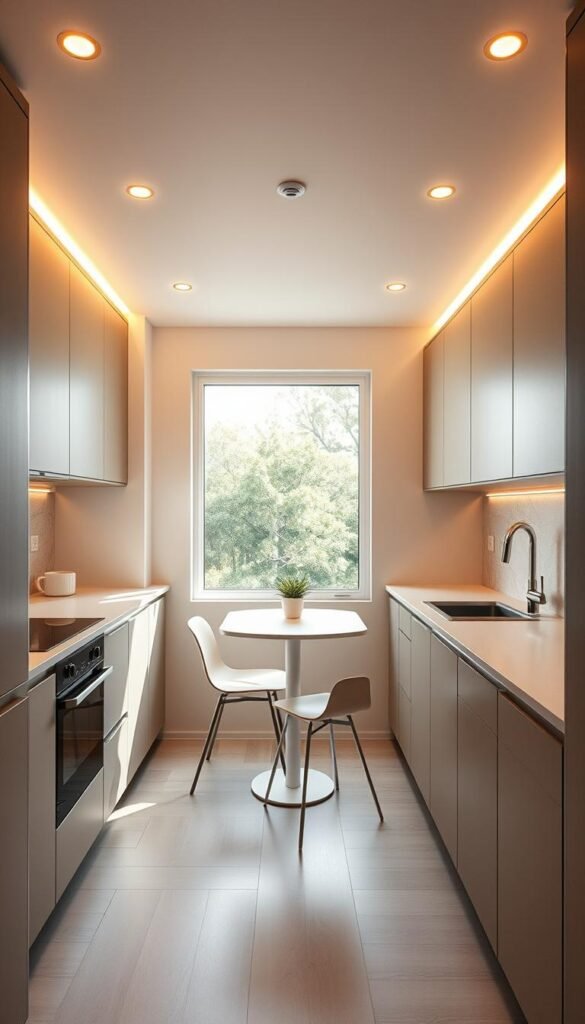
Space-Saving Appliances
Compact kitchens rely on space-saving appliances to maximize functionality. For example, 18-inch dishwashers and drawer-style microwaves are perfect for limited areas. Single-burner cooktops are another popular choice, offering versatility without taking up much room.
deVOL’s upper-cabinet-free designs are also gaining traction. These layouts create an airy feel, making the interior appear larger. Fold-down breakfast bars are another clever addition, especially in homes under 200 square feet.
Creative Storage Solutions
Storage is key in compact kitchens. Magnetic knife strips and under-cabinet jar storage keep essentials within reach while saving counter space. Abby Albers’ 800 sq ft lake cottage showcases the use of pegboard utensil walls, combining practicality with a stylish aesthetic.
Another standout feature is the integration of dual-purpose zones. For instance, a dining table that doubles as a workspace ensures every inch is utilized effectively. These solutions make small kitchens both functional and inviting.
| Feature | Traditional Kitchens | Compact Kitchens |
|---|---|---|
| Appliance Size | Standard | Space-Saving |
| Storage | Bulky Cabinets | Creative Solutions |
| Layout | Fixed | Flexible |
| Cost | Higher | Affordable |
By combining space-saving appliances and creative storage, compact kitchens are redefining efficiency. These design ideas ensure that even the smallest spaces can be both stylish and functional.
Bathroom Innovations in Tiny Homes
Bathrooms in compact spaces are no longer just functional—they’re stylish and efficient. With smart solutions and creative layouts, these spaces maximize every square inch while maintaining a modern aesthetic. From tankless toilets to waterproof vinyl flooring, every detail is designed to enhance both practicality and visual appeal.
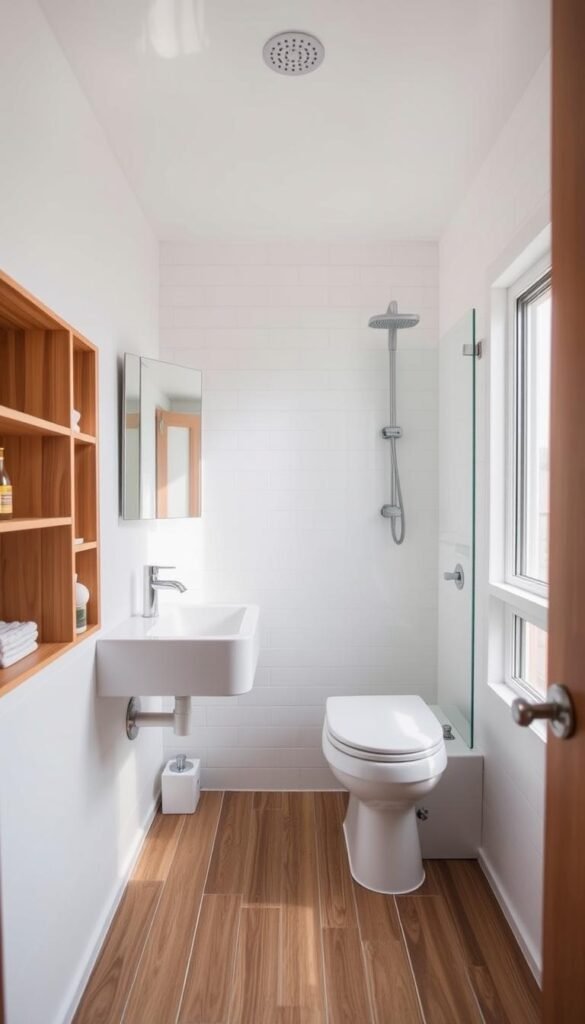
One standout trend is the use of wet rooms, which combine showers and sinks into a single, open area. This approach not only saves space but also creates a sleek, minimalist look. For example, designs inspired by Maine fishing shacks showcase how wet rooms can be both functional and visually striking.
Compact Fixtures and Fittings
When it comes to fixtures, tiny home bathrooms are all about efficiency. Tankless toilets and corner sinks can save up to 15% of the available space, making them ideal for compact layouts. Vessel sinks atop narrow vanities add a touch of elegance while maximizing storage options.
Pocket doors are another game-changer, especially in bathrooms as small as 30 square feet. These doors slide into the wall, freeing up valuable floor space. Combined with waterproof vinyl flooring, which is both durable and easy to maintain, these features create a bathroom that’s as practical as it is stylish.
For more inspiration on compact bathroom design, explore how these innovative solutions can transform your space. By integrating smart fixtures and creative layouts, you can create a bathroom that’s both functional and visually appealing.
Lighting Solutions for Tiny Homes
Effective lighting solutions can transform even the smallest areas into functional and stylish environments. Whether it’s maximizing natural light or incorporating creative artificial options, the right approach can make a significant difference in how a space feels and functions.
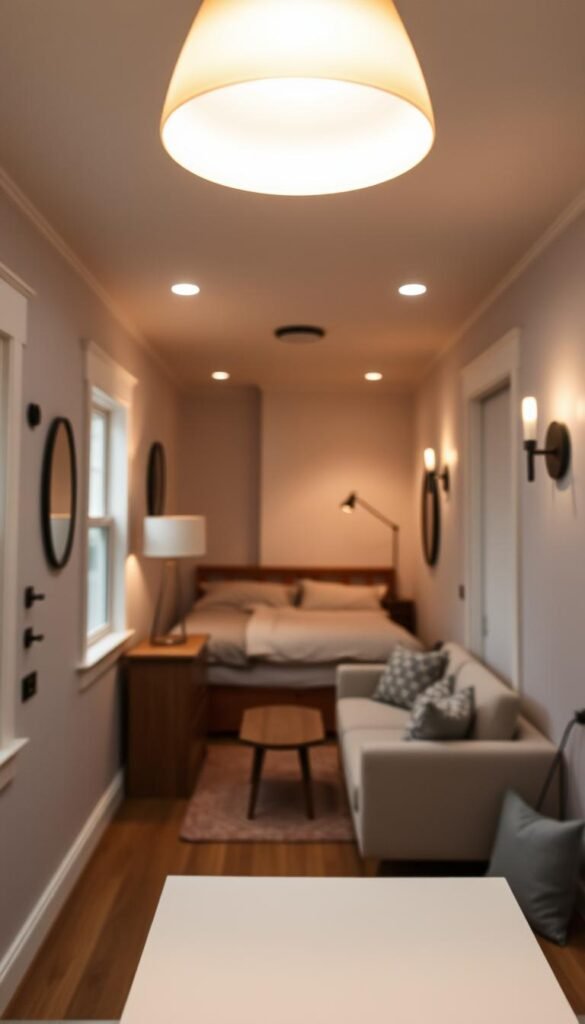
Maximizing Natural Light
One of the best ways to enhance a compact space is by letting in as much natural light as possible. Skylights, like those in the Montauk beach cottage, are a popular choice for loft bedrooms. They flood the room with sunlight, creating a bright and airy atmosphere.
Christina Salway’s 75-window treehouse is another excellent example. The extensive use of windows maximizes daylight, making the interior design feel open and spacious. Reflective surfaces, such as mirrors or light-colored paint, can further amplify this effect.
Creative Artificial Lighting
When natural light isn’t enough, artificial lighting steps in to create ambiance and functionality. LED strip lighting under cabinets and stairs is a versatile option. It adds a soft glow while saving space, perfect for compact areas.
Pendant lights with dimmers are another great choice. They allow you to adjust the room’s mood, making it ideal for multi-purpose spaces. For those looking for cost-effective alternatives, solar tubes are an innovative solution. They channel sunlight into darker areas without the need for traditional windows.
For more tips on optimizing your living space, check out these lighting hacks. By combining natural and artificial light, you can create a tiny house that’s both practical and inviting.
Flexible and Mobile Tiny Home Designs
Flexibility and mobility are reshaping the way we think about living spaces. As the house movement evolves, more people are embracing designs that allow them to live anywhere, anytime. These mobile solutions are perfect for those who value freedom and adaptability.
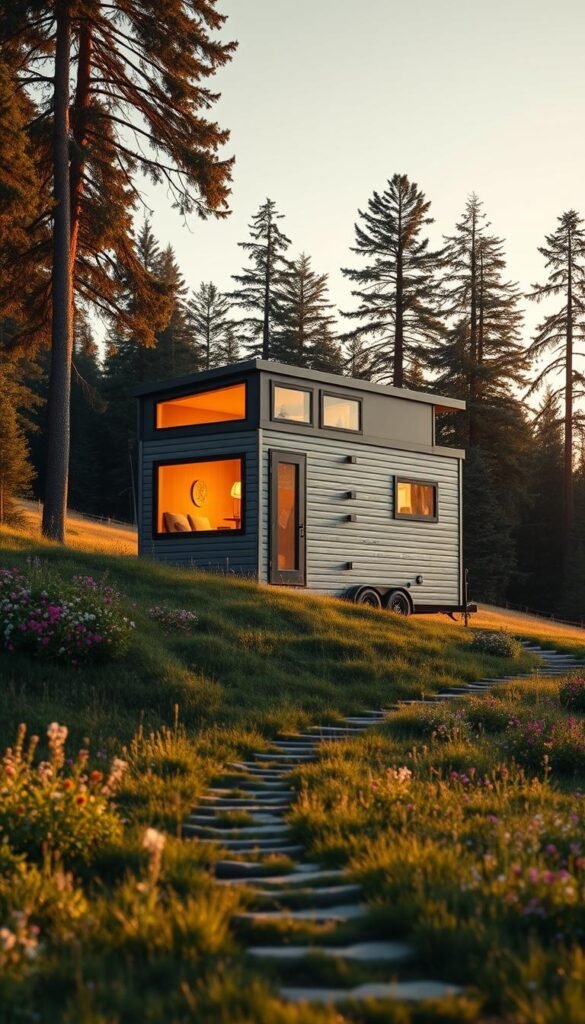
Trailer-Based Tiny Homes
Trailer-based designs are at the forefront of this trend. Gooseneck trailers, for example, enable cross-country living with ease. Lyndsay Caleo Karol’s 49-foot tugboat home on Canandaigua Lake is a standout example, blending creativity with functionality.
Pop-out walls are another innovative feature, offering temporary floor space expansion when needed. These designs are ideal for those who want to maximize their living area without sacrificing portability.
Portable Living Solutions
Portable homes often come with tax advantages, especially when classified as RVs. This makes them a cost-effective option for many. Lightweight materials like aluminum siding are also popular, making towing easier and more efficient.
For instance, the trailer-based WorkPod mini is a compact yet versatile solution for modern living. Its mobile design allows users to set up a functional space wherever they go, proving that size doesn’t limit comfort or style.
- Gooseneck trailers enable cross-country living.
- Pop-out walls provide temporary space expansion.
- RV-classified homes offer tax advantages.
- Lightweight materials like aluminum siding simplify towing.
Community-Oriented Tiny Home Developments
Communities are redefining the way we live, focusing on shared spaces and collaboration. These developments are not just about houses; they’re about creating a tiny home lifestyle that fosters connection and sustainability. From shared gardens to communal kitchens, these neighborhoods are designed to bring people together.
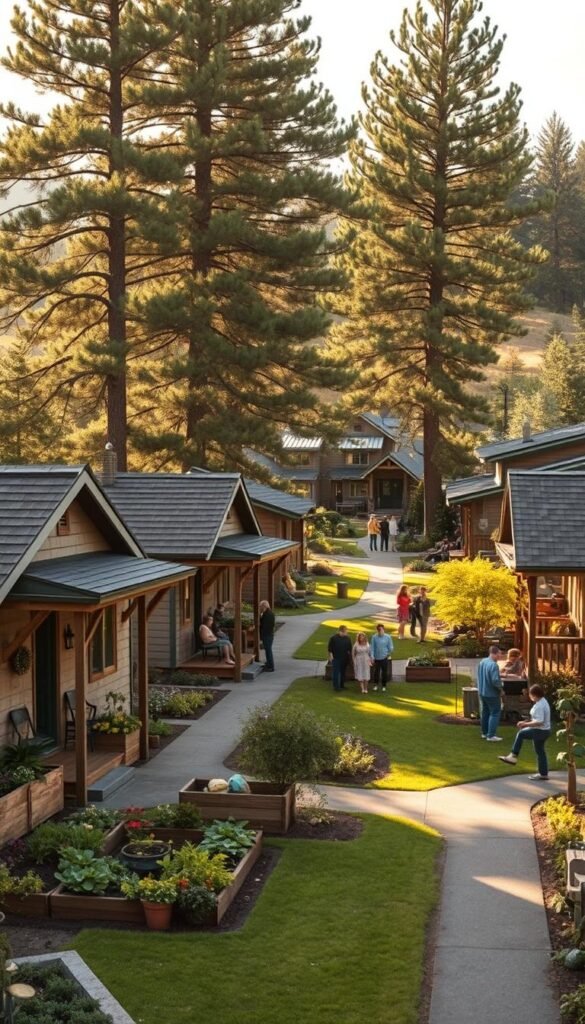
Shared Amenities and Spaces
One of the hallmarks of community-oriented developments is the use of shared amenities. For example, 55+ communities often feature communal gardens and workshops. These spaces encourage residents to interact and collaborate, enhancing the sense of belonging.
Urban developments are also embracing this trend. Rooftop gardens and shared laundry facilities are becoming common, reducing individual costs and promoting sustainability. Lili Liu’s Maine cottage cluster is a standout example, featuring a shared lobster-pound kitchen that brings neighbors together.
Collaborative Living Models
Collaborative living models are gaining traction as people seek more meaningful connections. Co-housing villages, for instance, often include communal kitchens and workshops. These spaces allow residents to share resources and skills, creating a more efficient and supportive environment.
Intergenerational neighborhoods are another growing trend. These communities bring together people of all ages, fostering a sense of unity and shared responsibility. By combining shared amenities with collaborative living, these developments are redefining what it means to live in a community.
Conclusion
The shift toward compact living is more than a trend—it’s a lifestyle revolution. From multi-functional furniture to eco-friendly materials and smart tech, these innovations are redefining how we live. The movement isn’t just about saving space; it’s about creating efficient, sustainable, and stylish environments.
Prefab ADUs, like the Autonomous WorkPod, offer flexibility for modern needs. With a predicted 22% annual growth in demand, this lifestyle is here to stay. As you explore these solutions, prioritize quality craftsmanship over square footage. Compact living proves that less can truly be more.



